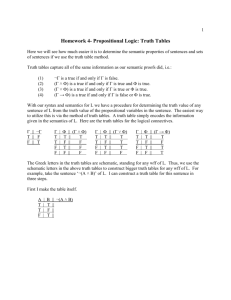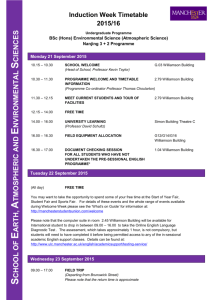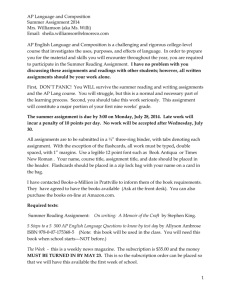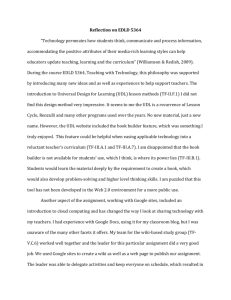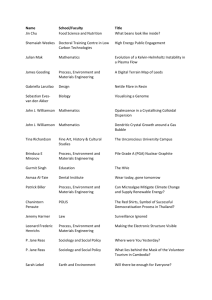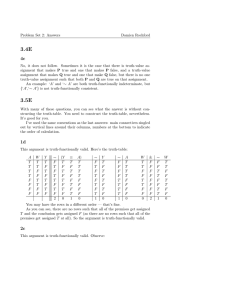Deflationism and Truth-Value Gaps
advertisement
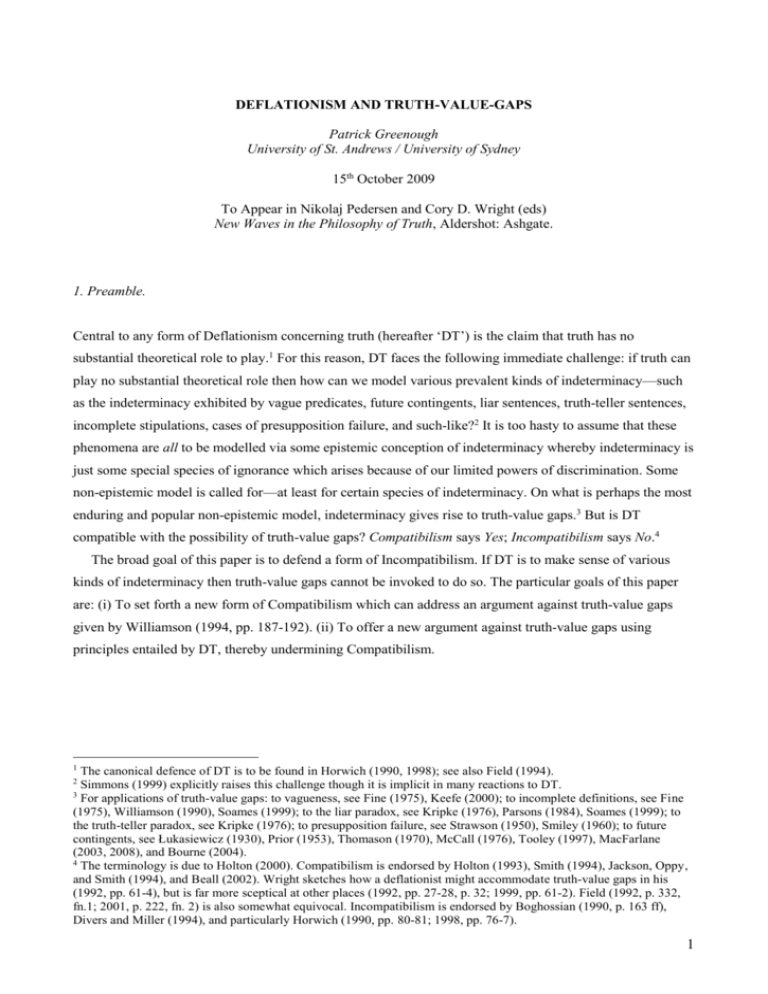
DEFLATIONISM AND TRUTH-VALUE-GAPS
Patrick Greenough
University of St. Andrews / University of Sydney
15th October 2009
To Appear in Nikolaj Pedersen and Cory D. Wright (eds)
New Waves in the Philosophy of Truth, Aldershot: Ashgate.
1. Preamble.
Central to any form of Deflationism concerning truth (hereafter ‘DT’) is the claim that truth has no
substantial theoretical role to play.1 For this reason, DT faces the following immediate challenge: if truth can
play no substantial theoretical role then how can we model various prevalent kinds of indeterminacy—such
as the indeterminacy exhibited by vague predicates, future contingents, liar sentences, truth-teller sentences,
incomplete stipulations, cases of presupposition failure, and such-like?2 It is too hasty to assume that these
phenomena are all to be modelled via some epistemic conception of indeterminacy whereby indeterminacy is
just some special species of ignorance which arises because of our limited powers of discrimination. Some
non-epistemic model is called for—at least for certain species of indeterminacy. On what is perhaps the most
enduring and popular non-epistemic model, indeterminacy gives rise to truth-value gaps.3 But is DT
compatible with the possibility of truth-value gaps? Compatibilism says Yes; Incompatibilism says No.4
The broad goal of this paper is to defend a form of Incompatibilism. If DT is to make sense of various
kinds of indeterminacy then truth-value gaps cannot be invoked to do so. The particular goals of this paper
are: (i) To set forth a new form of Compatibilism which can address an argument against truth-value gaps
given by Williamson (1994, pp. 187-192). (ii) To offer a new argument against truth-value gaps using
principles entailed by DT, thereby undermining Compatibilism.
1
The canonical defence of DT is to be found in Horwich (1990, 1998); see also Field (1994).
Simmons (1999) explicitly raises this challenge though it is implicit in many reactions to DT.
3
For applications of truth-value gaps: to vagueness, see Fine (1975), Keefe (2000); to incomplete definitions, see Fine
(1975), Williamson (1990), Soames (1999); to the liar paradox, see Kripke (1976), Parsons (1984), Soames (1999); to
the truth-teller paradox, see Kripke (1976); to presupposition failure, see Strawson (1950), Smiley (1960); to future
contingents, see Łukasiewicz (1930), Prior (1953), Thomason (1970), McCall (1976), Tooley (1997), MacFarlane
(2003, 2008), and Bourne (2004).
4
The terminology is due to Holton (2000). Compatibilism is endorsed by Holton (1993), Smith (1994), Jackson, Oppy,
and Smith (1994), and Beall (2002). Wright sketches how a deflationist might accommodate truth-value gaps in his
(1992, pp. 61-4), but is far more sceptical at other places (1992, pp. 27-28, p. 32; 1999, pp. 61-2). Field (1992, p. 332,
fn.1; 2001, p. 222, fn. 2) is also somewhat equivocal. Incompatibilism is endorsed by Boghossian (1990, p. 163 ff),
Divers and Miller (1994), and particularly Horwich (1990, pp. 80-81; 1998, pp. 76-7).
2
1
2. Against truth-value gaps.
The most sophisticated critique of truth-value gaps has been given by Williamson (1994, pp. 187-92).
Williamson’s basic thesis is simple: to deny bivalence is inconsistent in the presence of Tarski’s T-schemas
for truth and falsity, and yet to reject these schemas is to have no theory of truth at all. A simplified version
of Williamson’s argument runs as follows: suppose we have some sentence S which says that p. Suppose:
(1)
not: either S is true or S is false.
As S says that p, then this sentence is subject to the following familiar disquotational principles:
(T)
(F)
S is true if and only if p
S is false if and only if not-p.
We can then substitute the right-hand sides for the left-hand sides of T and F in (1), yielding:
(2)
not: either p or not-p
and by the relevant de Morgan’s law we derive the contradiction:
(3)
not-p and not-not-p.
Equally, a contradiction is also derivable given the following ‘equivalence schemas’ and the supposition that
not: <p> is true or <p> is false:
(EST)
<p> is true if and only if p
(ESF)
<p> is false if and only if not-p.5
Burgess (1998, p. 248) boldly claims that ‘nobody disputes the formal details of Williamson’s derivation’.
Moreover, this argument is given a very high profile in Williamson’s case for the epistemic view of
vagueness.6 Those who have sought to reject the epistemic view of vagueness (in its classical form at least)
have acknowledged the urgent need to block the argument (e.g. Travis 1999, fn.1). Furthermore,
Williamson’s argument provides a strong case for Incompatibilism since all forms of DT are committed to
both T and F (or both EST and ESF or cognate schemas). Indeed, it is one of the characteristic claims of DT
that all there is to be said concerning truth and falsity is exhausted by these schemas. Is there a response?
‘<p>’ abbreviates ‘the proposition that p’
Williamson’s argument is not new, though Williamson’s thorough discussion is distinctive. Similar versions appear in
McCall (1970, p. 83); see also Machina (1976).
5
6
2
3. The mutual entailment reading.
One way to respond to Williamson’s argument is to question the substitution step from (1) to (2). On this
score, the key question is: what reading should we give to the ‘if and only if’ used in the schemas T, F, EST,
ESF (and cognate schemas)? Horwich (1998, p. 21, fn. 5) suggests that EST and ESF should be read as
strict biconditionals, that is material biconditionals which hold of necessity. Thus, the left-hand sides and
right-hand sides of these schemas are substitutable salva veritate in all modal contexts. Various stronger
readings are possible. For example, one could take either side of these schemas to be (in some sense)
synonymous. This seems to have been the view of both Frege and Ramsey. However, let us take these
schemas to employ a material biconditional which holds of necessity.
On such a reading, it looks like these schemas must simply be rejected if one is to admit statements which
lack a truth-value. Dummett has famously argued for this point thus:
It is necessary to admit counter-examples to the schema (T) in any case in which we wish to hold that
there exist sentences which are neither true nor false: for if we replace [the right-hand side] by such a
sentence, the left-hand side of the biconditional becomes false [...], although, by hypothesis, the righthand side is not false (Dummett, 1978, p. 233).
Likewise for F: if the right-hand side of F is gappy, then the left-hand side is false, so left-hand side and
right-hand side do not match in truth-status.7 In a nutshell, Dummett endorses the following claim: If <p> is
neither true nor false (and S says that p) then ‘If p/not-p then S is true/false’ is not true and so schemas T/F
are not true. Dummett thus makes the following two assumptions:
(DA1) If <p> is neither true nor false (and S says that p) then ‘S is true/false’ is false.
(DA2) If <p> is neither true nor false, and <q> is false, then the conditional ‘if p then q’ is not true and
so the biconditional ‘p if and only if q’ is not true.
Given DA1 and DA2, Incompatibilism is all but inevitable.
Williamson’s aim is not to provide an argument in favour of Incompatibilism per se but rather to offer a
general argument against truth-value gaps. On this score, he argues that we cannot simply bolster the case for
truth-value gaps by abandoning the truth and falsity schemas since such a move ‘does nothing to meet the
rationale for (T) and (F)’ (1994, p. 190). What is that rationale? For Williamson, it derives Aristotle’s truth
dictum: ‘To say of what is that it is not, or of what is not, that it is, is false, while to say of what is that it is,
or of what is not that it is not, is true’. Williamson glosses this as follows:
Given that an utterance says that TW is thin, what it takes for it to be true is just for TW to be thin, and
what it takes for it to be false is for TW not to be thin (1994, p. 190).
7
Dummett (1978, p. 4) runs a similar argument against EST.
3
There is, however, a stock response to the predicament faced by the devotee of truth-value gaps, which,
on the face of it, appears to allow this rationale to be satisfied while admitting truth-value gaps. The idea is
that even though left-hand side and right-hand side of the schemas T and F, and the schemas EST and ESF,
do not bear a relationship of material or strict equivalence they nonetheless bear a relationship of mutual
entailment (see van Fraassen 1966, p. 494) or ‘inter-deducibility’ (see Smiley 1960, p. 129; McCall 1970, pp.
84-5; Keefe 2000, pp. 214-7). Thus, we have the following surrogates (given in terms of deducibility) for T
and F:
(T1)
(T2)
(F1)
(F2)
Given S is true one can infer p
Given p one can infer S is true
Given S is false one can infer not-p
Given not-p one can infer S is false
Truth-elimination
Truth-introduction
Falsity-elimination
Falsity-introduction
which are supposed to replace the strict equivalence reading of ‘if and only if’ in T and F. (Likewise,
analogue rules hold for the schemas EST and ESF.)
On that basis, so the thought goes, one can not only have an acceptable theory of truth/falsity via T1/2,
F1/2, which meets the Aristotelian dictum, one can also block the step from lines (1) to (2) in Williamson’s
proof, since while a strict equivalence reading of T and F sanctions the substitution step, a mutual
entailment/deducibility reading does not. So, a form of Compatibilism is back in the picture, whereby all
there is to be said concerning truth (and falsity) is exhausted by T1/T2 (and F1/F2).
That’s a well known response, but is it at all satisfactory? Williamson doesn’t address this response in his
discussion following the presentation of the above argument (given in Ch. 7 of his 1994). He does briefly
address the mutual entailment reading in an earlier Chapter on Supervaluational logic (ch.5). He says:
the mutual entailment reading fails to capture the disquotational idea. If the truth predicate really does
have the effect of stripping off quotation marks, then the material biconditional that ‘A’ is true if and only
if A strips down to the tautology that A if and only if A. The supervaluationist denies that supertruth
behaves like that; the availability of the mutual entailment reading is an irrelevance (1994, pp. 162-3).
These point here is somewhat compressed, but the claim seems to be that to fully capture the disquotational
properties of truth then the schema “A if and only if A” and the schema “‘A’ is true if and only if A” should
be interderivable. But that can be secured only if conditional proof is valid. But supervaluational logic, and
indeed any logic in which DA1, DA2, and the mutual entailment reading are valid, fails to validate the
inference from , A ├ ‘A’ is true to ├ A ‘A’ is true.8 In other words: since, conditional proof is
invalid, the mutual entailment reading fails to capture the basic disquotational idea. In what follows, I will
follow Williamson in maintaining that the mutual entailment per se reading is an irrelevance—though as we
shall on different grounds to those adduced by Williamson.
8
As a result the left-to-right direction of the deduction theorem , A ├ B if and only if ├ A B also fails.
4
4. Compatibilism defended.
The mutual entailment reading is indeed an irrelevance, but not for the reasons that Williamson advances.
The real issue is whether the schemas T1/2 and F1/2 contrapose. Typically of course, entailments do
contrapose, which is to say that when A ⊨ B then we can infer ~B ⊨ ~A (cf. Priest 1987, p. 109; Edgington
1993, p. 195). But then it looks as if when p ⊨ S is true then S is not true ⊨ not-p; likewise, when not-p ⊨ S
is false then S is not false ⊨ not-not-p. But then the contradiction returns: if S is not true it follows that not-p,
but if S is also not-false it follows that not-not-p. This is vital, for it tells us that it is not the material reading
of T and F that is driving Williamson’s proof, but the fact that T and F are contraposible. If they are
contraposible then the substitution step from lines 1 to 2 ought to be valid—whether one reads the ‘if and
only if’ in these schemas as a material relation or as relation of mutual entailment/deducibility. A natural
question then arises: can one then express T and F as non-contraposible material conditionals in order to
block the substitution step in Williamson’s proof? If so, one could save conditional proof and thus, by
Williamson’s lights, capture the disquotational properties of truth. Truth-value gaps and thus Compatibilism
would then be back in the picture.
To help us see how to do this, from, initially at least, the proof-theoretical point of view, it is useful to
borrow a technique developed by Prawitz (1965, pp. 76-8) which allows us to distinguish the ‘modal
formula’ of the language from the unmodalised formula—the relevant modality here being ‘It is true that’,
which we abbreviate with ‘T’. (For convenience, we can ignore the predicate ‘is true’—it’s easy to see how
the formal results which follow generalise to the formal mode of speech.) Say that: the wff TA, ~TA are
modal; and that the compounds A & B, A v B, A B are modal if their components are. When at least one
but not all components of a formula are modal say that the formula is ‘mixed’ (the term is due to von Wright
1986, 1987). (We also have the modality ‘It is false that’, abbreviated by ‘F’ which is definable in terms of T
and ~ as follows: FA if and only if T~A.)
We recognise three truth-values: {True (T), False (F), Neither True nor False (N)}. Despite the fact that
we admit a third truth-value, the classical inference patterns hold for the modalised fragment of the language.
This is a direct consequence of the semantics of strong truth: V(It is true that A) = T if V(A) = T, = F,
otherwise (Smiley 1960, p. 128; von Wright 1986, 1987).9
Firstly, we can give a restricted rule for the introduction of the classical material conditional, (which we
abbreviate with ‘’).
From , A ├ B infer ├ A B
(where A and all members of are either all modal or all
unmodal)
When the language is mixed, then we can also give an ‘impure’ rule (in Dummett’s sense) for the
introduction of this conditional as follows:
9
I restrict myself to the propositional fragment of the language as that is where all the action is.
5
From , A ├ B infer ├ TA B
(where A or some element of may be unmodal) 10
Neither of these rules allows us to prove the conditional ‘If A then it is true that A’. (This conditional is of
course a prototypical mixed formula.) To do that we need to introduce a weaker conditional ‘’ which
sustains detachment but which is non-contraposible. This has an introduction rule as follows:
From , A ⊢ B infer ⊢ A B
(for all A, B)
The corresponding biconditionals and are given by the following definitions A B =df (A B) & (B
A) and A B =df (A B) & (B A).
Given the rule of T-introduction which allows us to infer It is true that A from A, and the rule of Telimination which allows us to infer A from It is true that A, then the schema TA A is unrestrictedly
provable. Given the rule of F-introduction which allows us to infer It is false that A from ~A, and the rule
of F-elimination which allows us to infer ~A from It is false that A, then the schema FA ~A is also
unrestrictedly provable. Given the rules T1, T2, F1, and F2, given above then one can likewise prove that S
is true p, and S is false not-p.
Now to the semantics. Firstly, the semantics for the unary connectives is given as follows:
A
T
N
F
~A
F
N
T
TA
T
F
F
FA
F
F
T
This matrix ensures that T and F codify a strong notion of truth (and falsity) as per DA1. For the binary
connectives we have:
A
T
T
T
N
N
N
F
F
F
B
T
N
F
T
N
F
T
N
F
AB
T
N
F
T
T
N
T
T
T
AB
T
N
F
N
T
N
F
N
T
A&B
T
N
F
N
N
F
F
F
F
AvB
T
T
T
T
N
N
T
N
F
AB
T
N
F
T
T
T *
T
T
T
AB
T
N
F
N
T
T **
F
T **
T
This rule is structurally similar to the to the specification of an ‘impure’ version of the deduction theorem given by
Fine (1975, p. 295): ‘B is a consequence of A if and only if DA B is valid’ (where ‘D’ abbreviates ‘It is super true
that’). See also Keefe (2000, pp. 179-180).
10
6
The first four columns of this latter table are simply the familiar three-valued tables given by Lukasiewicz
(1930). Note that the -I rule ensures that the law of identity A A is provable even for the non-modal
fragment of the language. This law is not valid in either Kleene’s weak or strong systems, and consequently
the deduction theorem fails in those systems since A ⊢ A does hold. Since the deduction theorem is arguably
an absolutely basic logical principle, then this is a very good reason to reject the credentials of Kleene’s
systems (at least when the designated value is T and the intermediate value is N).
Of most interest, is the difference between ‘’ and ‘’ (marked by *). The conditional encodes the
thought that we are only concerned with whether truth is preserved from antecedent to consequent: if truth is
not so preserved (i.e. there is a drop in truth-value from T to N or F) then the conditional is invalid (not T on
all assignments) otherwise the conditional is valid (T on all assignments). The deduction theorem for is
given as ⊢ A B if and only if , A ⊢ B. An argument is invalid just in case there is an assignment of
truth-values under which its premises are true and its conclusion not-true, valid otherwise. That just reflects
the fact that T-introduction is valid even when applied to a premise which is gappy. But notice that
conditional is invalid in all cases where there is a ‘drop’ in truth-value from antecedent to consequent and
valid in all other cases. That’s just why A TA is not valid when A is gappy. Thus the deduction theorem,
given as ⊢ A B if and only if , A ⊢ B, is not valid (for mixed formula) since we do have A ⊢ TA.
Furthermore, while A B ⊢ ~B ~A, it is should be noted that A B ⊬ ~B ~A, and likewise A B,
~B ⊬ ~A. In other words the conditional ‘’ does not preserve falsity from antecedent to consequent—this
conditional does not support modus tollens nor contraposition.
But should we retain two conditionals in a language which may admit of truth-value gaps or should we
privilege one over the other? The fact that for the deduction theorem is not threatened and that one can
express the mutual material implication of ‘TA’ and ‘A’ tells in favour of . Indeed, on very general
grounds, why would one want a drop in truth-value from gappy antecedent to false consequent to tell against
a three-valued conditional? Truth is the property we hope to preserve in valid inference, not degree of truth,
or degree of acceptability, since in supposing a sentence we suppose it to be true—we are interested in what
follows from the truth of an assumption not what follows from its being neither true nor false. (Should we be
interested in what follows from the fact that a sentence is gappy then we have merely to assume that the
sentence is neither true nor false and see what follows.) Since is by far the more plausible conditional for
a gappy language (which contains mixed formula) then we have reason to entirely dispense with .
What, then, of the difference between and (marked by ** in the above matrix)? Very roughly, the
rationale behind is that a biconditional is invalid is there is no parity of truth between both sides, and valid
otherwise. In testing for invalidity, we are not interested in cases where there is a disparity in non-truth.11 It is
11
Rather than introduce a new biconditional into the language, Wright (1992, pp. 63-4) introduces a weak notion of
validity in addition to the strong notion, whereby a biconditional ‘A if and only if B’ is weakly valid if, although A may
in certain circumstances receive a different valuation from B, or may lack a truth-value when B does not, it is not
possible for either ever to be true unless the other is; and strongly valid if A and B necessarily always receive the same
valuation.
7
just these features which ensure that we can express the schemas EST, ESF, T and F as a non-contraposible
biconditional (the above matrices show that A B ⊬ ~A ~B). Thus, Dummett’s oft-quoted observation
that the left-hand side of T is false when the right-hand side is gappy, while correct, does not invalidate T.
This is because one needs both DA1 and DA2 to invalidate the truth and falsity schemas. In the system on
offer, DA1 is preserved, DA2 is not.
In general, two wff of the language, A and B, are substitutable salva veritate (in extensional contexts)
only if A B and ~A ~B (i.e. where A B). Since this condition is not met when A is gappy, then that
just shows why the substitution step in Williamson’s proof is invalid. Indeed, when the connective ‘if and
only if’ in T and F is taken to be non-contraposible this in no way undermines the intuitive Aristotelian
rationale for the validity of these schemas. It now ought to be clear why the mutual entailment reading of T
and F is a red-herring: there’s no reason to reject the idea that T and F bear a material equivalence relation,
at least so long as this relation does not sustain classical contraposition. Thus, when is the only
biconditional for the mixed language, a logic for truth-value gaps can have a respectable truth-theory,
contrary to what Williamson has argued. So, truth-value gaps are back in the picture and Compatibilism is
not thereby ruled out.12
5. The transparency platitude.
To believe, hope, suppose, doubt, judge, deny, fear that p is to believe, hope, suppose, doubt, judge, deny,
fear that it is true that p, and vice versa. Such is the so-called transparency platitude (see Kalderon 1997). As
Wright puts it, <p> and <it is true that p> are ‘attitudinally equivalent’ (1999, p. 62). Moreover, Wright calls
this platitude the ‘master platitude’. Standard forms of DT typically take all there is to be said concerning
truth to be exhausted by the T and F schemas or by EST and ESF or indeed by cognate schemas. But should
the transparency platitude also be one of the principles which, together with these schemas, exhausts all there
is to be said concerning truth? For our purposes it does not matter: all forms of DT will entail that either the
transparency platitude is derived from the truth-schemas (in conjunction with some other non truth-theoretic
principles) or indeed that the transparency platitude is non-derivative and is part of the central story to be
told about truth.
Of more immediate relevance is how to read the transparency platitude. If one reads the ‘is’ in the
platitude as the is of identity then it the propositional attitude of judging that p, for example, just is the
propositional attitude of judging that it is true that p. But if these attitudes are identical then they must be
directed at the same content, and so <p> and <It is true that p> have the same content. But if that is so then
these contents ought to be substitutable salva veritate in a version of Williamson’s proof and so truth-value
12
One immediate worry one might have with this proposal is that it is embedded within a truth-functional formal
system. It is a further question—which I will not address here—as to whether one could adopt in a non-truth
functional gappy system like a supervaluational logic.
8
gaps are ruled out. That’s a bit quick. Suppose one recognises the distinction between so-called content sense
and ingredient sense. Here’s Dummett on the distinction:
we must distinguish […] between knowing the meaning of a statement in the sense of grasping the
content of an assertion of it, and in the sense of knowing the contribution it makes to determining the
content of a complex statement in which it is a constituent: let us refer to the former as simply knowing
the content of the statement, and to the latter as knowing its ingredient sense (1973, pp. 446-447).
Given this distinction, one immediate thought might be that while <p> and <It is true that p> have the same
content sense they nonetheless differ in their ingredient sense, specifically the sense they have when
embedded under negation. So, the thought goes, <not-p> and <It is not true that p> are not substitutable
salva veritate, and so Williamson’s proof can be blocked.
Whatever the merits of this gambit, I want to offer an argument against truth-value gaps which relies on a
weaker reading of the transparency platitude whereby we read the ‘is’ as merely enforcing some kind of
necessary connection between, for example, the propositional attitude of -ing that p and the propositional
attitude of -ing that it is true that p. Moreover, the distinction between content and ingredient sense is
irrelevant to this argument as we shall see.
Suppose we read the transparency platitude for denial as enforcing the following principle:
(1)
Necessarily, S denies that p iff S denies that it is true that p.
But the following is also surely a platitude governing the relationship between denial and acceptance:13
(2)
Necessarily, S denies that p iff S accepts that it is not the case that p.
An instance of (2) is:
(3)
Necessarily, S denies that it is true that p iff S accepts that it is not the case that it is true that p.
Suppose S accepts that it is not true that p. Then by the r-to-l direction of (3) we get:
(4)
S denies that it is true that p.
Given the r-to-l direction of (1) we get:
(5)
S denies that p
and given the l-to-r direction of (2) we get:
13
Replace ‘denial’ with ‘reject’ if you don’t approve of my terminology (which is that of Parsons 1984).
9
(6)
S accepts that not-p.
Given conditional proof (and the closure of necessity) we get:
(7) Necessarily, if S accepts that it is not true that p then S accepts that not-p.
Furthermore, the propositional attitude of supposing is just a kind of hypothetical acceptance. So, when one
hypothetically accepts that it is not true that p then one thereby hypothetically accepts that not-p. But now we
have:
(8) Necessarily, if S supposes that it is not true that p then S supposes that not-p
But (8) causes trouble for truth-value gaps.14
If to suppose that it is not true that p just necessitates that one is thereby supposing that not-p then this
will automatically license any inference one makes from it is not true that p to not-p.15 In other words, the
act of supposing the premise already in effect includes the act of supposing the conclusion which means that
one is always thereby entitled to infer the conclusion from the premise. Given the uncontroversial inference
from not-p to it is false that p, we then have that from it is not true that p one can infer that it is false that
p. Since truth-value gaps are incompatible with this entailment then the validity of the transparency platitude
straightforwardly rules out truth-value gaps. Indeed, since it is uncontroversial that from not-p one can infer
it is true that not-p, then it follows that from it is not true that p we can infer it is true that not-p, which is
just to show that the equivalence schema EST is contraposible; ditto for the schemas ESF. But if these
schemas are contraposible then the form of Compatibilism defended in §4 is a non-starter. DT is
incompatible with truth-value gaps after all. Consequently, DT should look elsewhere for a non-epistemic
model of indeterminacy.16
14
In fact (7) causes trouble for truth-value gaps in any case, but one gets a more general result if one goes via (8).
Here the assumption is that these propositional attitudes are not identical, merely that there is a necessary connection
between the two attitude states.
16
Arguably, what is required instead, at least for certain species of indeterminacy, is a truthmaker gap model of
indeterminacy; see Sorensen (2001), Greenough (2008). It is a further question whether such truthmaker gap models are
compatible with a deflationary conception of facts.
15
10
BIBLIOGRAPHY
Beall, JC (2002): ‘Deflationism and Gaps: untying ‘not’s in the debate’, Analysis, 62, pp. 299-305.
Boghossian, P. (1990): ‘The Status of Content’, Philosophical Review, 99, pp. 157-84.
Bourne, Craig (2004): ‘Future Contingents, Non-Contradiction, and the Law of Excluded Middle’, Analysis,
64, pp. 122-128.
Burgess, J. (1998): ‘In Defence of an Indeterminist Theory of Vagueness’, Monist, 81, pp. 233–52.
Divers, J. and Miller, A. (1994): ‘Why Expressivists about Value should not Love Minimalism about Truth’,
Analysis, 54, pp. 12-19.
Dummett, M. A. E. (1973): Frege: Philosophy of Language, London: Duckworth.
Dummett. M. A. E. (1978): Truth and Other Enigmas, London: Duckworth.
Edgington, D. (1993): ‘Wright and Sainsbury on Higher-Order Vagueness’, Analysis, 53, pp. 193–200.
Field, H. (1992): Critical Notice of Truth by P. Horwich, Philosophy of Science, 59, pp. 321–330.
Field, H. (1994): ‘Deflationist Views of Meaning and Content’, Mind, 103, pp. 247–285.
Fine, K. (1975): ‘Vagueness, Truth, and Logic’, Synthese, 30, pp. 265–300.
Fraassen, B. C. van (1966): ‘Singular Terms, Truth-Value Gaps, and Free Logic’, Journal of Philosophical
Logic, 63, pp. 481–495.
Greenough, P. (2008): ‘Indeterminate Truth’, Midwest Studies in Philosophy.
Holton, R. (1993): ‘Minimalisms About Truth’, in Themes from Wittgenstein, in K. Milligan and B. Garrett,
(eds) 45-61, Canberra, Australia: ANU Working Papers in Philosophy 4.
Holton, R. (2000): ‘Minimalism and Truth-Value Gaps’, Philosophical Studies, 97, pp. 135–65.
Horwich, P. (1990): Truth, 1st edition, Oxford: Blackwells.
Horwich, P. (1998): Truth, 2nd edition, Oxford: Oxford University Press.
Jackson, Oppy, and Smith (1994): ‘Minimalism and Truth-Aptness’, Mind, 103, pp. 287-302.
Kalderon, M. (1997): ‘The Transparency Property of Truth’, Mind, 106, pp. 475–97.
Keefe, R. (2000): Theories of Vagueness, Cambridge: Cambridge University Press.
Kripke, S. (1975): ‘Outline of a Theory of Truth’, Journal of Philosophy, 72, pp. 690-716.
Lukasiewicz, J. (1930): ‘Many-Valued Systems of Propositional Logic’, in S. McCall (ed.),
Polish
Logic, Oxford: Oxford University Press, 1967.
Machina, K. (1976): ‘Truth, Belief, and Vagueness’, Journal of Philosophical Logic, 5, pp. 47–78.
MacFarlane, J. (2003): ‘Future Contingents and Relative Truth’, The Philosophical Quarterly, 53, pp. 321336.
McCall, S. (1970): ‘A Non-Classical Theory of Truth with an Application to Intuitionism’, American
Philosophical Quarterly, 7, pp. 83–88.
McCall, S. (1976): ‘Objective Time Flow’, Philosophy of Science, 43, pp. 337-362.
Parsons, T. (1984): ‘Assertion, Denial, and the Liar paradox’, Journal of Philosophical Logic, 13, pp. 137–
52.
Prawitz, D. (1965): Natural Deduction: A Proof-Theoretical Study, Uppsala: Almqvist and Wiksells.
11
Priest, G. (1987): In Contradiction: A Study of the Transconsistent, The Hague: Nijhoff.
Prior, A. N. (1953): ‘Three-Valued Logic and Future Contingents’, The Philosophical Quarterly, 3, pp. 317326.
Smiley, T. (1960): ‘Sense Without Denotation’, Analysis, 20, pp. 125–35.
Smith, (1994): ‘Why Expressivists about Value Should Love Minimalism about Truth’, Analysis 54, pp. 112.
Soames, S. (1999): Understanding Truth, Oxford/New York: Oxford University Press.
Sorensen, R. A. (2001): Vagueness and Contradiction, Oxford: Oxford University Press.
Thomason, R. (1970): ‘Indeterminist Time and Truth-Value Gaps’, Theoria, 3, pp. 264-281.
Tooley, M. (1997): Time, Tense, and Causation, Oxford: Oxford University Press.
Travis, C. (1999): ‘Sublunary Intuitionism’, in Brandl and Sullivan (eds), New Essays on the Philosophy of
Michael Dummett, Rodopi: BV Editions.
Williamson, T. (1990): Identity and Discrimination, Oxford: Blackwells.
Williamson, T. (1994): Vagueness, London/New York: Routledge.
Williamson, T. (1995): ‘Definiteness and Knowability’, Southern Journal of Philosophy, 33, (supplement),
pp. 171–91.
Williamson, T. (1997): ‘Imagination, Stipulation, and Vagueness’, in E. Villanueva (ed.) Truth:
Philosophical Issues, vol. 8, Atascadero, CA: Ridgeview.
Wright, C. (1992): Truth and Objectivity, Cambridge, MA: Harvard University Press.
Wright, C. (1999): ‘Truth: a Traditional Debate Reviewed’, Canadian Journal of Philosophy, suppl. vol. 24,
and reprinted in S. Blackburn and K. Simmons (eds), Truth, Oxford: Oxford University Press, 1999, pp.
203–38.
Wright, G. H. von (1986): ‘Truth, Negation, and Contradiction’, Synthese, 66, pp. 3–14.
Wright, G. H. von (1987): ‘Truth-Logics’, Logique et Analyse, NS 30, pp. 311–34.
12
